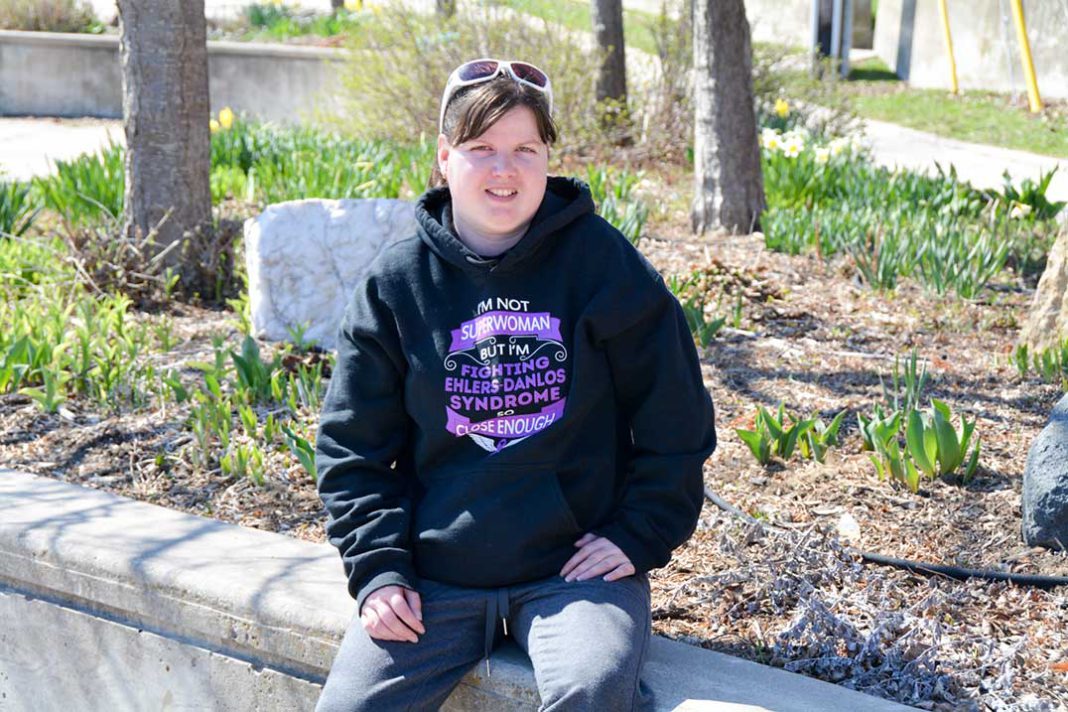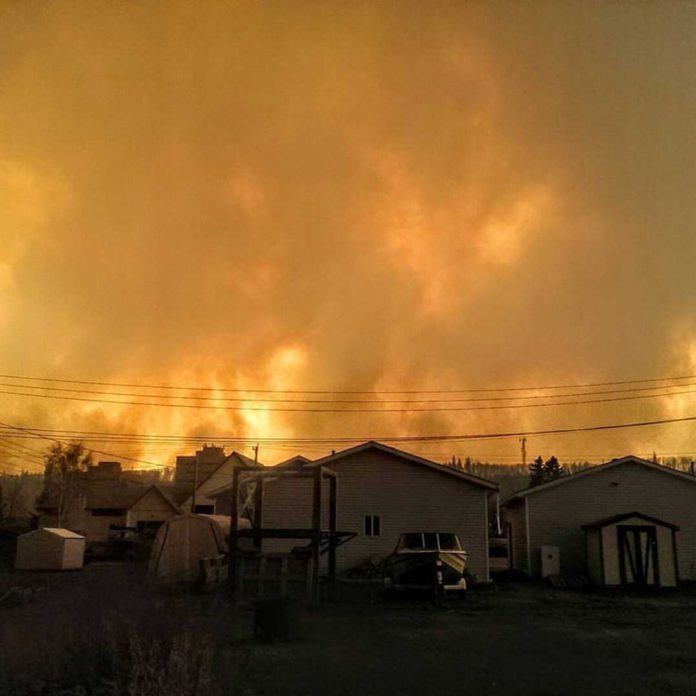LITTLE CURRENT—The pain of losing her twin sister is never far from the surface, but Kari Bourque takes some solace in knowing that the rare disease that took her sister’s life at age 22, and only days after giving birth to her son, is not bringing pain and suffering to her now.
In January 2010, the Little Current twin sisters, known for their tiny statures and big attitudes, were driving home from Health Sciences North having just visited Kayla Bourque’s new baby boy (who had to be hospitalized at birth) when the unthinkable happened. Kayla took an attack in the car, dying with her sister by her side. A coroner’s report revealed that Kayla had died as a result of a ruptured aorta, but also uncovered something else; the young woman had been living with Ehlers-Danlos Syndrome (EDS) type four, or also known as the ‘vascular type,’ and he contacted Kari to see a geneticist as soon as possible as it was likely that she carried the disorder too.
Following some testing it was confirmed—the disease that took the closest person to Kari was now shadowing her life at every turn.
For people living with the genetic disorder, it means that they are lacking in the collagen found in the connective tissue of healthy people which means they are prone to tearing or rupture.
“Mutations in the COL3A1 gene cause the vascular type of Ehlers-Danlos Syndrome,” the Ehlers-Danlos Network website states. “The protein made by the COL3A1 gene is used to assemble larger molecules called type III collagens. Collagens provide structure and strength to connective tissue throughout the body. Type III collagen is mostly found in skin, blood vessels, and internal organs. If the structure or production of type III collagen is altered by a mutation in the COL3A1 gene, collagen fibrils cannot be assembled properly in these tissues and the signs and symptoms of the Vascular Type of Ehlers-Danlos Syndrome result.”
Some signs of people living with EDS type four are thin, fragile skin that bruises easily; visible veins beneath the skin, particularly on the chest and abdomen; hands and feet with an aged appearance; protruding eyes; a thin nose and lips; sunken cheeks; and a small chin. Other signs can be an unusual range of motion of hand and foot joints; tearing of tendons and muscles; painfully swollen veins in the legs; lung collapse; and slow wound healing. Infants born with the disease could also be born with club feet.
Growing up, Kari shares, she and her sister were always bruised, so much to cause their mother enough concern to bring them to the hospital on occasion. The girls were always pale too, with translucent skin. And in the final month of Kayla’s pregnancy, she suffered a collapsed lung.
Three years after the passing of Kayla and her own diagnosis, Kari helped her cousin create a video about EDS type four as part of a college assignment. In it, the tiny 25-year-old sits in her home and shares with the viewer information about the disease and how it has changed her life. She spoke of her once athletic lifestyle and that she can no longer participate in any activity that increases her heart rate. Kari also shares the difficulty she finds in working since standing for any prolonged time causes wear and tear on her joints. She suffers from leg tremors, near sightedness, irritable bowel, anxiety and depression.
Now, one month away from 29 and seven years after her diagnosis, things are much different for Kari. “Man, I look different, eh?” she references her younger self in the video, shaking her head.
As she shares her story in this newspaper’s editorial office she complains about the swelling in her face. The once 90-pound woman has gained almost 40 pounds of unexplained weight, causing her cheeks to swell. She says that it was recently discovered that she has elevated levels of prolactin in her system, a hormone normally produced by pregnant women or women who have just given birth and which is responsible for milk production. Doctors are currently looking into how to lower these levels and, she hopes, help her to lose the weight from her small frame.
“I don’t have much energy,” she says slowly. “I have a hard time sleeping now, and I have leg and neck pain,” she adds, rubbing the back of her neck.
Kari explains that she’s also been diagnosed with gastroparesis, basically a paralysis of the stomach. “I need to take a pill to keep food down, I need to take a pill to help me digest, and I need to take a pill to help me go to the washroom.”
When asked if she required a special diet, she says that while she should be on such a regimen, “it doesn’t matter what I eat; I get sick most days.”
She’s now on nine different medications daily and going through a new round of testing.
Kari is no longer able to work either. “I’m an ECE (early childhood educator), but I just can’t do it. When I wake up I see how I feel and go from there.”
She spends a lot of time doing her own research as she feels the knowledge on EDS type four in Canada is limited, but has heard that a special clinic will soon be opening in Toronto and is looking forward to that day. Her appointments are spread between Sudbury and Toronto and she must have a yearly MRI and echocardiogram to check on her internal organs. Kari credits much of her help to her gynecologist, cardiologist and gastroenterologist.
Through her days as she puts one foot in front of the other, sister Kayla is always on her mind.
“It never gets any easier,” she whispers, tears spilling down her cheeks. “I thought it would have by now, but it doesn’t. Brutal.”
“Sometimes I think it’s a blessing because I know she’s not living with this,” Kari adds, looking down. “As much as I want her here, I know she’s not going through this.”
Kari explains that the month of May is Ehlers-Danlos Awareness Month, pointing to her hoody which reads ‘I’m not superwoman, but I’m fighting Ehlers-Danlos Syndrome, so close enough.’
She says she’d like people to take the time to learn about EDS. “There’s no guarantee there will be a tomorrow for anybody, but for someone like me…”
She shares that her future weighs on her a lot. “I’m limited to so much.”
Among her many other symptoms, Kari also has rheumatoid arthritis, has become sun sensitive and noticed a change in her short term memory. “My hands and feet go black at random times too,” she adds.
Kari says she likes to help out with Legion dinners when she’s able, plays darts on Tuesday nights and was looking forward to the dance being held there last weekend, but these things don’t keep her mind off of the fact that she will likely see more symptoms. Over 80 percent of people with her form of EDS will see life threatening complications, like the one that took Kayla’s life, by age 40.
“It’s hard to find something to do for the day,” she says softly. “My stomach issue limits me a lot. I’m always in pain.” She says she hopes to participate in the upcoming Alzheimer’s Walk with her family, or at least do as much of the walk as she can.
Kari says she will continue to spread awareness about the disease that runs her life, and took her sister’s, and hopes that one day there will be a cure.
When the twins were born, they were well known across Manitoulin for their determination to survive, being born premature and weighing just 1 lb, 14 ounces.
“I came into this world fighting. I guess that’s how I’ll leave it too.”




